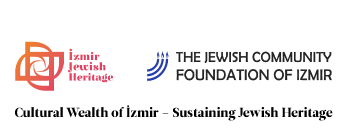Hayim Palachi
(1788-1868)
Hayim Palachi was born in 1788.
From his early years, Hayim was in the presence of important religious leaders and received an intense education. In a short time, as a clever and enthusiastic boy, Palachi emerged as unique among his peers. When he was a student at Yeshiva at the age of 20, he married Rabbi Yitzhak Gatenyo’s daughter. They had two girls and 3 boys. Rabbi Hayim Palachi worked with Rabbi Rafael Yosef Hazan to prepare and publish the book, Simha le Hayim.
At the age of 25, Hayim Palachi received the title of “Haham Hashalem – Haham Kumplido” in Yeshiva. Rabbi Hayim Algazi honored him with this title and appointed him to the rabbinate. While his father was alive, he did not want to take any official duties. Yet, when his father passed away in 1827, he accepted the position of Dayan and Shofet. He also became the head of Beit Yaakov Rabi Yeshiva where he completed his education.
In 1849, he was appointed to the community’s Beth Din. Together with Beth Din members, Yesua Shelomo Arditi, Hayim Binyamin Pontremoli, Rahamim Nisim Yehuda de Sigura, Nisim Hayim Moshe Modai and 45 other rabbis, they ran the Beth Din and provided religious leadership for the community.
Aside from writing his books, he answered hundreds of questions from individuals and communities of various cities. His main principle was to answer all the letters and questions. His interpretations, explanations, and rulings were accepted around the world, and communities began to teach his doctrines. Rabbi Palachi maintained correspondence with leading Sephardic and Ashkenazic rabbis. In 1852, with an edict written by Sultan Abdulmecid, he was appointed as chief Rabbi of Izmir.
His reputation spread throughout Ottoman lands, and in 1858 he was awarded a medal by Sultan Abdulmecid. At the same time, the Sultan granted him the rights of jurisdiction and the rights to judge according to both Ottoman and to Jewish religious laws. In this capacity, he became the legal judge of the Jews in Izmir. Later on, he was awarded a second medal by Sultan Abdulmecid.
As the Chief Rabbi of Izmir, he eased the administrative rules. He tried to apply the halakha in a way that made daily life easier. Meanwhile, his first wife died and three years later, he married a Vida Nama.
During his Rabbinate period, he gave importance to social welfare; and as an important mission, he thought of founding a Jewish hospital. He received the necessary support from Rotschilds and from Sir Moses Montefiore. The Jewish hospital was established.
Rabbi Hayim Palachi was very sensitive to events that affected Jews outside Izmir as well. During the blood libel in Damascus in 1840, he called for the support of his Egyptian Jewish friend Don Avram Kamando, Baron de Rothschild and Sir Moses Montefiore. Through their intercession, the innocent Jewish victims in Damascus were exonerated.
With the beginning of Tanzimat period—when the Ottoman government introduced modernization reforms– we observe changes that were beginning to occur within the Jewish community of Izmir. Until then, the community was solely directed by its own Beth-Din; but with the Tanzimat, a council made up of a lay board of directors was formed. This secular administrative council had the authority to control the income of the community.
Rabbi Hayim Palachi wrote 72 books in total. The names of his books always included the word “hayim”. This was both an allusion to his name, as well as an allusion to the Torah being a source of life.
As he grew old, he became increasingly weak. When he died a few months later, on 17 shevat 5628, many Jewish and non-Jewish people from Izmir attended his funeral. Due to their respect, many tradesmen closed their businesses and attended his funeral. With the Sultan’s order, an official ceremony was arranged, with part of the Ottoman army in attendance.
Rabbi Palachi was buried in Bahri Baba Jewish cemetery.

